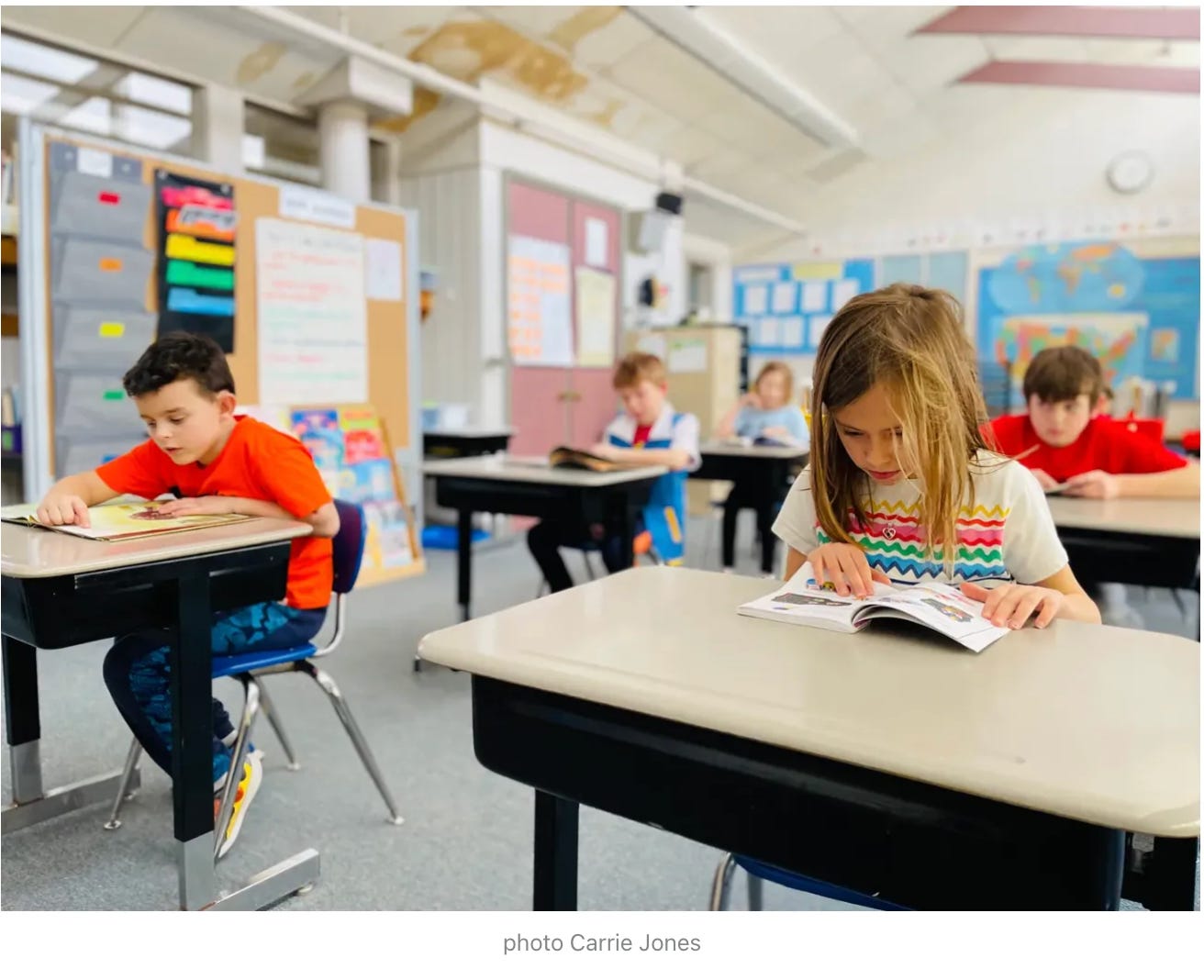Why is building and renovating schools so expensive?
Maine Department of Education data of state-funded major construction projects shows how costs have grown in recent years.
By Lana Cohen of the Maine Monitor
BAR HARBOR—The price tag on a new elementary school in Bar Harbor is $63 million. An Auburn high school completed in 2023 came in at $122 million. And at the ballot box this fall, Cape Elizabeth voters will consider a $94.7 million bond that would be used to build a new middle school and renovate the district’s elementary and high schools.
Since the start of the COVID-19 pandemic, the average price of school construction in the United States has increased by 32 percent, according to the Bureau of Labor Statistics.
There is no statewide data showing the change in the average per-square-foot cost of school construction, but Maine Department of Education data of state-funded major construction projects shows how construction costs have grown in recent years.
In 2015, it cost $270 per-square-foot to rebuild an elementary school. In 2017, it cost $313 and in 2018, $379. In 2023 the cost jumped to $491 and in 2024 reached $661. The cost of building middle and high schools in the state follows the same trend.
This uptick stems from inflation, labor shortages, and a supply and demand imbalance.
“Post-COVID demand fueled by lower interest rates and post-pandemic recovery in conjunction with supply chain disruptions affected materials costs globally,” said Denis Garriepy, chief operating officer of Scarborough-based Landry/French Construction Company. “As an industry, we just could not get enough wood, steel, concrete and other equipment for what we were looking to build.”
In Maine, which has the oldest population in the nation, a labor shortage in the construction trade has exacerbated the situation. Labor shortages raise labor expenses, which are passed on to consumers.
Though school construction costs have gone up, the projects are cheaper than other non-residential construction such as hospitals and offices, which require more expensive infrastructure and finishes, leaders in the construction field said.
But unlike hospitals and office buildings, the cost of school construction is a fraught subject because taxpayers feel the direct burden, in property taxes and large periodic bonds put to voters to fund school infrastructure projects.
Funding dilemmas
The state has two construction funds — one for major renovations and rebuilds, and one for minor fixes — but that money is limited.
In 2018, only nine of the 74 schools that applied for major construction funding from the state were chosen to receive it.
The state funding cycle comes around every five years and is constrained by the amount of debt — currently $150 million per year — the state can accrue to finance school construction. The application for the latest round was due Aug. 30. The state does not know when it will announce the approved projects, said Department of Education spokesperson Marcus Mrowka.
The state’s Revolving Renovation Fund, which offers loans that are partially forgiven, is capped at $2 million per priority per school building in a five-year period.
That means for many of the state’s 569 schools, school districts must ask local taxpayers to shell out for construction or do without necessary repairs.
While asking taxpayers already stretched thin to help pay for school construction can put them in a tight spot, foregoing repairs can leave students at best without useful resources and at worst in unsafe buildings.
Scarborough town council member Nick McGee said balancing those interests is like a “tight-rope act.”
McGee, with other community leaders, is working to create a palatable school construction bond proposal after voters soundly rejected the school district’s request to take out a $160 million bond to renovate its aging and overcrowded schools last fall.
“As a community leader, the last thing you want to do is force someone out of their home,” said McGee, who said he is particularly concerned about residents on fixed incomes being so overburdened by property taxes that they can’t afford to stay in their homes. “But we have a real space issue in the schools that requires investment from the community.”
Modern facilities
Four years ago, Bath opened its new Morse High School. The largely state-funded $78 million project replaced a nearly century-old school with a state-of-the-art facility complete with a fitness center, small rooms where students can work quietly, and a health center.
The best thing Morse Principal Eric Varney heard from a student after the move was that going to school in the new building made them want to try harder.
The Oxford Hills School District in western Maine has two major renovations planned. In 2022, Agnes Gray and Oxford Hills Middle were chosen to receive major construction funds from the state. Superintendent Heather Manchester said she looks forward to having modern facilities.
“The big goal is for our kids to have amazing educational opportunities,” said Manchester. “I would love our buildings to contribute to education rather than create obstacles.”
Oxford Hills and the state have yet to nail down the cost of the projects.
Agnes Gray Elementary School, built in 1890, closed abruptly in February after an inspection found a long list of safety concerns. Students have attended two nearby schools while waiting for repairs. Oxford Hills Middle School is over capacity, said Manchester.
Manchester hopes the district will be able to build schools that allow kids to get the support they need. To Manchester, that means rooms for occupational, speech and physical therapy, conference rooms where parents can meet with teachers and administrators, and outdoor spaces and facilities where kids can do hands-on projects.
“If we want to keep kids engaged, we need to find authentic ways for them to engage in the content and they can’t just be sitting at a desk all day listening to a teacher talk,” said Manchester. “School buildings and spaces should reflect the collaborating students need to do.”
This story was originally published by The Maine Monitor, a nonprofit and nonpartisan news organization. To get regular coverage from the Monitor, sign up for a free Monitor newsletter here.
For related coverage of Bar Harbor’s school construction, please check out the following stories or search “Conners Emerson” at our website:
If you’d like to donate to help support us, you can, but no pressure! Just click here.
If you’d like to sponsor the Bar Harbor Story, you can! Learn more here.
Thank you for considering it!











Cost per square foot for school construction is a largely meaningless statistic unless you know precisely what those square feet contain. Alexis de Tocqueville a French political theorist/journalist visited the USA in 1831 to study our democracy. Near the end of his stay he predicted that democracy would only last until voters discovered that they could vote themselves a free lunch. (or a free education?)
I don't know the average tax burden of the average family living in Bar Harbor but I feel confident that a family with 3 children taking advantage of public school education is getting the best deal for their buck they'll ever experience. The average cost of a private elementary school tuition in Maine is $14,573. (Connor Emerson's tuition in 2022/23 was $14,583) Let's do the private school math: 3 kids x $14,573 = $43,719 x 8 years = $349,752! But that figure is added to by the subsequent 4 years in high school. The average cost of a private high school education in Maine is $29,614 per year. Let's do the math: 3 kids x $29,614 x 4 years = $118,456! So the average cost of a grade 1 through grade 12 private school education for a family with 3 children is: $349,752 + $118,456 = $468,208. Heck let's just round it off and call it half a million dollars. Bar Harbor's numerous tax increases over the past 12 year period make it impossible to calculate precisely how much the parents of those 3 kids have paid in property taxes so I'll just use a perhaps overly generous estimate of $6,000 a year (it would have been much lower 12 years ago). Let's do the math again $6,000 x 12 years = $72,000. Now lets subtract that figure from the total cost of the average grade 1 through 12 private school education in Maine: $468,208 - $72,000 = a (non taxable) net savings of...drum roll please...$396,208!
So while it is certainly true that building material, labor, and transportation costs have increased the per square foot cost of constructing public schools I have a strong hunch that parental pressure to build Cadillac quality schools might be playing a major roll as well.
Were Alexis de Tocqueville alive today he'd probably say, "Don't say I didn't warn ya!"